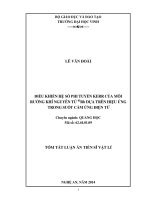Section 2 6 TRƯỜNG ĐIỆN TỪ
Bạn đang xem bản rút gọn của tài liệu. Xem và tải ngay bản đầy đủ của tài liệu tại đây (95.91 KB, 7 trang )
Slide Presentations for ECE 329,
Introduction to Electromagnetic Fields,
to supplement “Elements of Engineering
Electromagnetics, Sixth Edition”
by
Nannapaneni Narayana Rao
Edward C. Jordan Professor of Electrical and Computer Engineering
University of Illinois at Urbana-Champaign, Urbana, Illinois, USA
Distinguished Amrita Professor of Engineering
Amrita Vishwa Vidyapeetham, Coimbatore, Tamil Nadu, India
2.6
The Law of
Conservation of Charge
2.6-3
Law of Conservation of Charge
d
S J • dS + dt V dv 0
J
(t)
V
S
dS
Current due to flow of charges emanating from a closed surface S =
Time rate of decrease of charge
enclosed by S.
2.6-4
Summarizing, we have the following:
Maxwell’s Equations
d
C E • dl = – dt B • dS
d
C H • dl = J • dS + dt D • dS
S D • dS = V dv
S B • dS = 0
(1)
(2)
(3)
(4)
2.6-5
Law of Conservation of Charge
d
S J • dS dt V dv 0
(5)
(4) is, however, not independent of (1), whereas (3)
follows from (2) with the aid of (5).
2.6-6
Example: Finding
H d l around C.
C
dS
I1
S
Q(t)
I2
C
d
C H • dl = I2 dt S D • dS
(Ampére’s Circuital Law)
1
S D • dS = 2 Q
(Gauss’ Law for the electric field
and symmetry considerations)
2.6-7
dQ
I2 – I1
0
dt
(Law of Conservation
of charge)
dQ
I1 – I2
dt
d 1
H d l I2 Q
C
dt 2
1
I2 I1 I2
2
1
I1 I2
2









